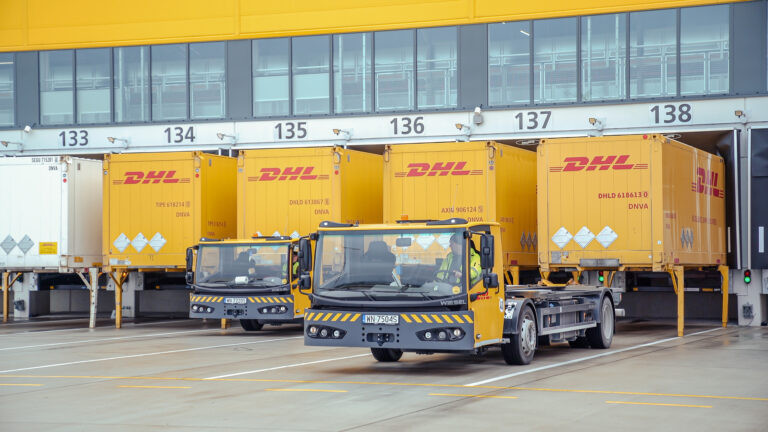When direct air connections are limited or cost-prohibitive, Road Feeder Services (RFS) step in to keep shipments moving. These ground-based links play a vital role in ensuring that time-definite airfreight reaches its destination on schedule—without the need for a direct flight. By integrating road transport into its air network, DHL Express uses RFS to close logistical gaps, streamline operations, and offer customers more flexible and cost-effective delivery options.
Not every location can be reached quickly by air alone. In areas where flights are infrequent, expensive, or simply unavailable, RFS provides a practical solution. “DHL integrates feeder services into its airfreight network by using road transport to connect regions lacking direct air connectivity, thus optimising overall efficiency,” Cain Moodie, EVP, Network Operations & Aviation, DHL Express Europe, explained. This model allows the company to consolidate shipments and reduce costs, especially in areas where flying cargo might be inefficient or financially impractical.
But the role of RFS isn’t limited to bridging gaps. “Due to our outstanding and flexible network, DHL uses feeder services not only for regions where there is no air connection but also in parts as a generally preferred option,” Moodie continued. The strategy allows for both operational efficiency and environmental benefits, particularly in mature logistics markets. “In some countries, such as Germany, many connections can also be linked with the RFS without any service loss for our customer.”
From dry ice-packed pharmaceuticals to temperature-sensitive perishables, feeder services underpin DHL’s most time-critical offerings. “Feeder services support DHL’s TDI (Time Definite International) and DDI (Day Definite International) services by providing reliable ground transportation for high-value shipments or dry ice transports,” Moodie noted. “This integration ensures that these critical shipments maintain their required delivery timelines while adhering to strict handling protocols.”
Adaptation and resilience
As global trade spans diverse regulatory environments and infrastructure maturity levels, DHL tailors its RFS strategies across regions to remain effective and compliant. “The function and strategic value of feeder services vary across DHL’s key markets due to differences in regional infrastructure, customs processes, and regulations,” said the spokesperson.
For example, in Europe, the emphasis is often on optimising speed and efficiency. But elsewhere, the challenge may be more foundational. “In Africa, it might prioritise overcoming logistical challenges and ensuring compliance with local regulations,” they said, highlighting the adaptive nature of DHL’s RFS deployments.
Importantly, RFS isn’t just a fallback for underserved areas—it’s often the recommended choice. “DHL recommends feeder services over direct air freight in scenarios where cost sensitivity is a priority, or when direct air options are unavailable,” Moodie confirmed. By blending affordability with predictable lead times, RFS gives customers a strategic edge in budget-constrained supply chains.
There’s also a clear environmental dimension to DHL’s road-first approach in certain lanes. “To reduce carbon emissions, DHL utilises feeder services as a more sustainable alternative to short-haul flights, which are often more polluting,” Moodie explained. In line with broader industry shifts toward greener logistics, DHL is looking ahead. “The company is also exploring investments in greener road freight technologies, such as electric and alternative-fuel trucks, to further enhance sustainability in its logistics operations.”
Visibility, security, and seamless transitions
Coordinating air and road legs in a single shipment demands precision. DHL meets this requirement through a combination of technology and standardised protocols. “DHL ensures end-to-end shipment visibility for airfreight using checkpointing and ODD (On Demand Delivery),” Moodie said, underlining its commitment to transparency—even in remote or cross-border areas.
In a world where weather disruptions and congestion can derail even the best-laid logistics plans, RFS offers an important buffer. “Feeder services enhances the reliability and resilience of DHL’s airfreight services by providing alternative ground transportation options during disruptions in air cargo schedules, such as weather or congestion,” Moodie noted. “In this way, feeder services acts as a contingency tool, ensuring that shipments can still reach their destinations on time.”
Security, particularly for high-value and regulated cargo, remains uncompromised across modes. “As we are applying all security measures for all TDI shipments the same, there is no difference whether air or road transport (planned and unplanned), ensuring the safe transport of sensitive shipments,” Moodie confirmed.
On the operational front, key hubs like Frankfurt, Hong Kong, and Chicago anchor DHL’s RFS network. These locations are carefully chosen and integrated with air schedules to minimise delays. “Feeder services are synchronised with flight schedules to minimise ground time and facilitate efficient transloading, ensuring timely connections,” Moodie added.
The future of multimodal freight
Operating across borders adds a layer of complexity, particularly in regions with less streamlined customs processes. “DHL faces regulatory and customs challenges when operating feeder services across international borders, particularly in regions like Africa and Southeast Asia, where compliance can be complex,” Moodie acknowledged. However, the solution lies in local expertise and digital tools. “To mitigate delays and compliance risks, DHL employs local expertise and advanced customs technologies to streamline processes.”
Beyond air and road, DHL Express also works selectively with other transport modes. However, practicality dictates the scope. “Rail and sea freight are not really helping the TDI business, as the transit times are not optimised for time-definite shipments,” Moodie explained. That said, strategic coordination between feeder and air services remains a cornerstone of DHL’s logistics approach. “DHL Express coordinates between feeder services and air to create flexible, multimodal logistics solutions tailored for complex supply chains, such as those in the automotive or industrial sectors.”
This adaptability extends to value-added services, further enhancing the client experience. “Feeder services play a crucial role in supporting DHL’s value-added services, such as customs clearance, White Glove delivery, and dry ice transports, as part of its airfreight-forwarding solutions,” Moodie said. For enterprise clients, these services are not piecemeal—they’re bundled into tailored logistics packages. “These services are often bundled for enterprise clients to provide comprehensive logistics support tailored to their specific needs.”





